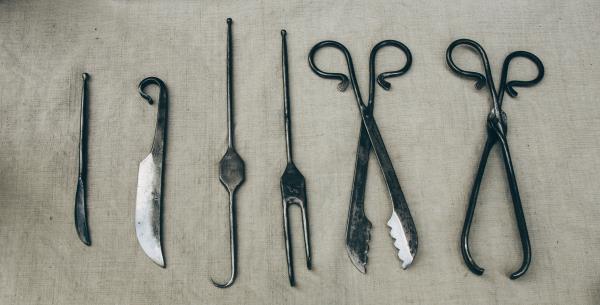ABU AL-QASIM AL-ZAHRAVI (Albucasis) (936 – 1013 C.E.)
Abul Qasim Al-Zahravi, known in the West as Albucasis, was undoubtably the greatest surgeon of the Middle Ages. He is best known for several original breakthroughs in surgery, as an inventor of several surgical instruments, and for his famous Medical Encyclopedia. Al-Zahravi is considered as Father of Modern Surgery.
His full name was Abul Qasim Khalaf ibn al-Abbas al-Zahravi. He was born and brought up in Zahra, the royal suburb of Cordova (Arabic Qurtuba), the capital of Muslim Spain. As we know from the history, Zahra competed in grandeur and magnificence with Baghdad and Constantinople. Al-Zahravi served in the capacity of the court physician to King Al-Hakam-II of Spain. After a long and distinguished medical career he died in 1013 C.E.
Al-Zahravi was a prominent surgeon. Patients and students from all parts of Europe came to him for treatment and advice. According to Will Durant, Cordova was in this period the favorite resort of Europeans for surgical operations. Dr. Campbell in ‘History of Arab Medicine’ says that Al-Zahravi‘s principles of medical science surpassed those of Galen in the European medical curriculum.
Al-Zahravi is famous for his thirty-volume medical encyclopedia ‘Al-Tasrif li man ajaz an-il-talif (the English translation of the title would read ‘An aid to him who lacks the capacity to read big books’). Three volumes of this vast encyclopedia deal with the surgical knowledge including his own inventions and procedures. The last volume contains many diagrams and illustrations of more than two hundred surgical instruments, most of which he developed. Al-Zahravi gave detailed description of many surgical operations and their treatment, including cauterization, removal of stone from the bladder, surgery of eye, ear and throat, midwifery, removal of the dead foetus, amputation, dissection of animals, and stypics.
 As an inventor of many surgical instruments, Al-Zahravi is famous for developing instruments for internal examination of the ear, internal inspection of the urethra and for applying or removing foreign bodies from the throat. He introduced such new procedures as cauterization of wounds, crushing stones inside the bladder, the vivisection and dissection. He applied cauterization procedure to as many as 50 different operations. In addition, Al-Zahravi discussed the preparation of medicines and the application of such techniques as sublimation and decantation. He prescribed the use of diuretics, sudorifics, purgatives, the absorption of pure wine and hot baths. Al-Zahravi was the first to give detailed description hemophilia and was the first to use silk thread for stitching wounds.
As an inventor of many surgical instruments, Al-Zahravi is famous for developing instruments for internal examination of the ear, internal inspection of the urethra and for applying or removing foreign bodies from the throat. He introduced such new procedures as cauterization of wounds, crushing stones inside the bladder, the vivisection and dissection. He applied cauterization procedure to as many as 50 different operations. In addition, Al-Zahravi discussed the preparation of medicines and the application of such techniques as sublimation and decantation. He prescribed the use of diuretics, sudorifics, purgatives, the absorption of pure wine and hot baths. Al-Zahravi was the first to give detailed description hemophilia and was the first to use silk thread for stitching wounds.
Al-Zahravi was also an expert in oral surgery and dentistry. Al-Tasrif contains sketches of complex instruments that he developed. He discussed the problem of non-aligned or deformed teeth and procedures to rectify these defects. In addition, he developed the procedure for preparing and setting artificial teeth made from animal bones.
Gerard of Cremona (1114-1187) translated Al-Tasrif into Latin in the Middle Ages. It was then translated into Hebrew, French, English and into Latin dialect of the Provencal. Al-Zahravi’s Al-Tasrif was an essential component of the medical curriculum in European countries for many centuries. The famous French surgeon Guy de Chauliac (1300-1368) appended its Latin edition to his own book on surgery. Several editions of this book (surgical chapters) were published including one at Venice (1497), at Basel (1541) and at Oxford (1778). This book was taught for approximately five centuries as a standard textbook on surgery at universities of Salerno in Italy, Montpellier in France, and several European universities.












